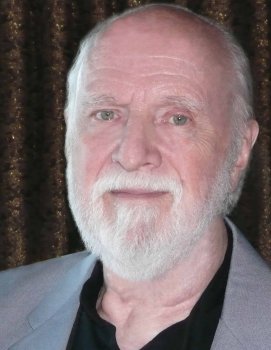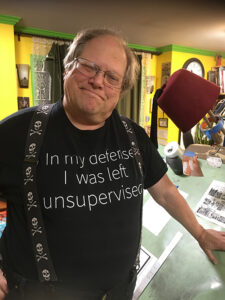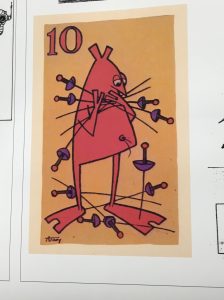(1) IN THE BEGINNING. Philip Athans asks everyone, “Don’t Be Hatin’ On Prologues (Again)” at Fantasy Author’s Handbook.
… Anyway, once again we’re being told that all prologues are bad, no books should ever have a prologue, and all authors who write prologues are bad, and anyway, it’s best to just skip over them if one should have the nerve to appear….
…Let’s take this monumental misconception in two parts. First, the notion that prologues are optional and no one reads them.
As both an editor and a reader I have never in my life skipped a prologue or in any way went in thinking it was not necessary to the story. Not one time, not ever. This notion is so alien to me I can’t even begin to understand the origin of it.
Richard Lee Byers, author of Called to Darkness and The Reaver (neither of which happen to have prologues) tried to help: “…the assumption is that the prologue is an info dump. Beyond that, even if it’s exciting in its own right, there’s a feeling that if Chapter 1 switches to different characters or is Ten Years Later, you’ve thrown away whatever narrative momentum you might have built up.”
There should never be an assumption that a prologue is an info dump, because prologues should never be info dumps—not ever, not under any circumstances. And yes, even if your world is really complex and you’ve spent years worldbuilding and you’re sure no one will understand your story unless you “set the scene” or teach them all about your amazing world, and all that nonsense. If this is what your prologue is doing, that’s why your book is being rejected, not because it has a prologue, but because it has a crappy prologue….
(3) HISTORY AND MORAL PHILOSOPHY. Canadian sff author D.G. Valdron writes about “Moral Compromise and the Lesson of the Hugos” on Medium.
… Well, the Hugos Scandal isn’t the battle for Civil Rights. But the sort of moral compromise and coercion that King criticized is on display here, and it’s frightening how unnecessary it was, how shallow virtue turned out to be.
How do we really act, how do we really think or behave, how virtuous are we if we are genuinely tested, if there’s a real push. How often have you bowed your head and simply gone along to get along.
And how brave will you be when there are real consequences? When taking a stand actually can get you arrested, or get you fired from your job, or get you beaten up? How principled are you, when there’s money involved, either to lose or to gain? When principles mean some form of inconvenience? When principles mean going against the crowd?
Sadly, I think that most of us won’t be. We’ll be just like the Hugo folk….
(4) THE FIRST. “’No one had done it before him’: the groundbreaking stories of Black astronauts” – the Guardian discusses the documentary film The Space Race.
…Glover describes the tension of code switching between his professional and personal lives. He is a military officer and Nasa astronaut – he will pilot the upcoming Artemis II mission that will orbit the moon – but also a Black man in America. “Is it really possible to have a double consciousness? No, but you almost have to think of it that way: there’s a bit of me that I am at home and then there’s a bit of me that I am at work, and the overlap is kind of small.”…
(5) STEVE MILLER (1950-2024). Sff author Steve Miller died this afternoon. His wife and co-author Sharon Lee told Facebook readers:
He went downstairs to take a walk at about 4:30. At about 5:30, I thought he’d been awhile and went downstairs to see what was going on.
He was on the floor, unconscious, and not breathing. I called 911, and did CPR until the ambulance and EMTs arrived. They did everything they could, but his heart just wouldn’t beat on its own.
Miller’s health had been failing; he recently wrote his own obituary, which Sharon Lee has allowed File 770 to post (see “Steven Richard Miller (July 31, 1950 – February 20, 2024)”.)
Steve and Sharon Lee declared themselves partners in life and in writing in 1978. They married in November 1980, and moved from Maryland to Skowhegan, Maine, in October 1988 after the publication of their first joint novel, Agent of Change, the first in what was to become a long series of space opera novels and stories set in their original Liaden Universe®. A book in that series, Scout’s Progress, won the 2002 Romantic Times Book Club Reviewers Choice Award for Best Science Fiction Novel.
Steve was an active member of fandom in earlier years, as Director of Information of the Baltimore Science Fiction Society for some time, and as vice-chair of the bid committee to hold the 1980 Worldcon in Baltimore (they lost to Boston).
The SF Encyclopedia says Steve began publishing work of genre interest with “Shalgiel” for Flux Magazine in 1976, one of his few solo works. He began collaborating with Sharon with “The Naming of Kinzel: The Foolish” (June 1984 Fantasy Book); and all his novels have been with Lee, primarily the Liaden Universe® sequence.
Steve ran his own small press from 1995 through 2012, specializing in chapbooks containing 2-3 short stories set in the Liaden Universe® and other settings from books by him, Sharon Lee and other authors.
For awhile Steve and Sharon ran Bookcastle & Dreamsgarth, Inc., a genre bookstore with a traveling convention SF art agency component.
Steve and Sharon were honored together in 2012 with NESFA’s Skylark Award, given for contributions to SF in the spirit of E.E. “Doc” Smith.
(6) TODAY’S BIRTHDAY.
[Written by Cat Eldridge.]
Born February 20, 1926 — Richard Matheson. (Died 2013.) Now we come to Richard Matheson. So where shall I start? From a genre viewpoint, we should start with the Hugo he would share at Solacon for The Incredible Shrinking Man, directed by Jack Arnold from Matheson’s screenplay based off his novel.
What next? Well The Twilight Zone, of course. He scripted thirteen episodes of which “Nightmare at 20,000 Feet” with William Shatner is certainly the best-known. I’d also single out “Little Girl Lost” for just being out really, really scary, again it’s based off a story of his. Also, “Nightmare at 20,000 Feet” became part of the Twilight Zone film.

Oh, sweet mother, he was prolific! I mean really, really prolific. Just cinema films alone totaled up to at least twenty-eight: television work adds another thirty-four. So no, I’m not covering these in detail, am I?
Matheson’s famous novel I Am Legend was made into three movies – but he wondered in an interview why it kept being optioned when no one ever made a movie that actually followed the book. He hated The Last Man on Earth, so he’s credited as Logan Swanson instead. It got made twice more, as The Omega Man, and much later as I Am Legend with Will Smith.
Now where was I? (The phone rang from a medical office. Lots of those these days.) Ahhh, series work.
The Night Stalker was his greatest success. The Night Stalker first aired in January 1972, and garnered the highest ratings of any television movie at that time. Matheson would receive an Edgar Award from the Mystery Writers of America for Best TV Feature or Miniseries Teleplay.
He scripted but a single episode of The Girl from U.N.C.L.E., “The Atlantis Affair” and none of the other U.N.C.L.E. series.
He did “The Enemy Within” episode of the Trek series, not one that I consider to be all that great.
Remember in the Jack Palance Birthday I mentioned Dracula, also known as Bram Stoker’s Dracula and Dan Curtis’ Dracula? Well guess who the scriptwriter was for it?
He’s the scriptwriter of The Martian Chronicles, the good, the bad whatever of that series. Seen it at least three times, still love the original version much more.
He was involved in Twilight Zone: Rod Serling’s Lost Classics. The first and much shorter segment, The Theatre, was expanded and scripted by him from a Serling outline.
Now his fiction.
Thirty novels which with the exception of the ones of the ones I’ve already noted and The Shrinking Man and The Night Stalker novels, I recognized absolutely nothing. What I found fascinating is that half of the nearly thirty novels had become films. Nearly all with him writing the scripts for them.
Short stories. Oh yes. And as I’ve mentioned previously, many of them were adapted by him into scripts for such series as The Twilight Zone. He’s got literally dozens of collections but not being one who’s read him deeply, I cannot recommend what ones are the best to acquire.
(7) COMICS SECTION.
- Mannequin on the Moon makes a grotesque joke about early book bans.
- Nancy has a new take on a classic.
- Saturday Morning Breakfast Cereal adds to the Three Laws – Lise Andreasen says, “I think you’ll find no. 4 is Wil Wheaton’s law.”
- Frank and Ernest make a dumb pun, but not too dumb to link to.
(8) HOW EDUCATIONAL! The New York Times declares, “It’s Alive! EC Comics Returns”.
EC Comics, which specialized in tales of horror, crime and suspense, and was shut down in the “moral panic” of the 1950s, is making a comeback.
Oni Press will publish two new anthology series under the EC Comics banner. The first, Epitaphs From the Abyss, coming in July, will be horror focused; Cruel Universe, the second, arrives in August and will tell science fiction stories.
Hunter Gorinson, the president and publisher of Oni Press, said the new stories will interpret the world of today, much as EC Comics explored the American psyche of the 1950s. The cover designs will feel familiar to EC Comics fans: Running down the top left is a label declaring the type of story — “Terror” or “Horror” or “Science-Fiction” — and the logo evokes the bold colors and fonts of past series like “Tales From the Crypt” and “The Vault of Horror.”
The series are a partnership between Oni and the family of William M. Gaines, the original publisher of EC Comics, who died in 1992. Gary Groth, the editor of The Comics Journal, told The New York Times in 2013 that EC Comics was “arguably the best commercial comics company in the history of the medium.”….
(9) IT’S A JUNGLE OUT THERE. “I Went to Hogwarts for Seven Years and Did Not Learn Math or Spelling, and Now I Can’t Get a Job” is a 2020 humor piece from The New Yorker.
Dear Headmaster McGonagall:
I am a recent Hogwarts graduate, and, although my time with you was a literal fantasy, I unfortunately did not learn a lot of basic skills, like math or spelling, at your skool.You may say, “Why do you need arithmetic? You’re a wizard. You can do magic!” To which I reply, sure, for some wizard careers that’s great, but other wizards work in middle management and just want a normal nine-to-five gig. When I graduated, I thought that all I would need was my wand and a couple of choice incantations, but these days, without at least a little algebra, you’re not even qualified to work in Bertie Bott’s retail department…
(10) ARTIFICIAL SURE, INTELLIGENT? MAYBE. Not including any copies of the images was an easy choice: “The rat with the big balls and the enormous penis – how Frontiers published a paper with botched AI-generated images” at Science Integrity Digest.
… The authors disclose that the figures were generated by Midjourney, but the images are – ahem – anatomically and scientifically incorrect.
Figure 1 features an illustration of a rat, sitting up like a squirrel, with four enormous testicles and a giant … penis? The figure includes indecipherable labels like ‘testtomcels‘, ‘senctolic‘, ‘dissilced‘, ‘iollotte sserotgomar‘ and ‘diƨlocttal stem ells’. At least the word ‘rat‘ is correct.
One of the insets shows a ‘retat‘, with some ‘sterrn cells‘ in a Petri dish with a serving spoon. Enjoy!…
[Thanks to Mike Kennedy, Andrew Porter, John King Tarpinian, Kathy Sullivan, Daniel Dern, Lis Carey, Lise Andreasen, Michael J. “Orange Mike” Lowrey, John A Arkansawyer, Chris Barkley, Cat Eldridge, SF Concatenation’s Jonathan Cowie, and Steven French for some of these stories. Title credit belongs to File 770 contributing editor of the day Daniel Dern.]


